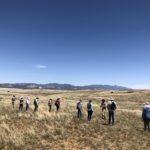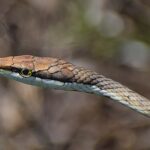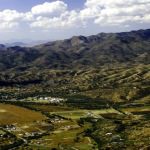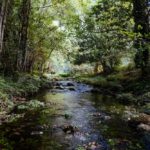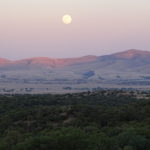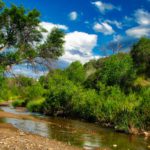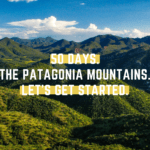With permission, we’ve re-posted John Davis’s Blog from the Wildland’s Network TrekWest Journey.
John’s Blog from TrekWest
With Patagonia Area Resource Alliance, Sky Island Alliance and Defenders of Wildlife, Early March
“A veteran fence-cutter myself (always legally, of course, removing old barbed wire from various wild way lands where I work back East), I could almost feel the sense of liberation as Sergio described taking the fence out of a wildlife corridor…”
Lobo stood with us symbolically atop American Peak as we gazed worriedly down on the proposed site of the Wildcat Silver Mine (below right). Lobo is a promise, an artistic expression of hope crafted by a Zuni sculptor. This small figurine and others (including jaguar and ocelot, which are also both native to southern Arizona but jeopardized by roads and the border wall) we bear with us on this wild walk-about. The proposed Wildcat Silver Mine is a curse visited upon the good wildlife and people of the Patagonia Mountains and surrounds. If the Wildcat Silver Mine plans are approved, the Southwest will lose a critical wildlife corridor, vibrant waters, and scenery to live for.
Patagonia Area Resource Alliance (PARA) and kindred groups aim to prevent this theft. Together with Defenders of Wildlife, Sky Island Alliance, and others, PARA is organizing local and state residents to oppose this mine. Please help them.
Our day was not all about threats and alarms, though. PARA leaders showed me Madrean oak/pine woodlands primordial in their beauty, and talked with me also about their work on sustainability. This work includes pollinator advocacy led by naturalist and writer Gary Paul Nabhan, with whom I serve on the Board of Directors of Wild Farm Alliance http://wildfarmalliance.org. As Gary’s research has shown, southern Arizona is a continental leader in diversity of bees, ants, bats, hummingbirds, and other animal groups that include pollinators critical to both native and cultivated plants. The great diversity of pollinators in the Sky Islands owes to its topographic, geologic, and vegetative diversity.
So does the Madrean Archipelago’s exceptional diversity in mammals, about which Sergio Avila of Sky Island Alliance told us as we strode the Patagonias. From atop American Peak, Sergio pointed out how these mountains, modest in stature but immense in diversity, reach south into Mexico and how parallel ranges also provide key corridors for animals like jaguars and ocelots. Sergio noted that the Sky Islands is one of the few areas north of the tropics where one can find four native cats: bobcat, cougar, ocelot, and jaguar, all of which are wide-ranging and need big wild interconnected habitats.
Sergio also pointed to the border wall, cutting across the San Rafael Valley and into the mountains, threatening to sever the connections that keep these mountains so rich. Some of the rugged areas along the border thus far have been spared the building of impassable fencing; and it should be an international conservation priority to keep these wildlife corridors wall-free. Sergio had a bit of heartening news for all of us: He and other Sky Island Alliance folks had recently spent some time, at the request of the Bureau of Land Management, removing the barbed wire along the US/Mexico border where agencies deemed a simple vehicle barrier to be enough of a deterrent to drug traffickers. A veteran fence-cutter myself (always legally, of course, removing old barbed wire from various wildway lands where I work back East), I could almost feel the sense of liberation as Sergio described taking the fence out of a wildlife corridor.
TrekWest Action: Please don’t forget, to help fight these threats, you can go to trekwest.org and sign the petition to Say YES to protecting our Fast-Disappearing Wildlife Habitat Corridors, which we will deliver to decision-makers who can speed up this important conservation need. Also support the worthy organizations featured in this blog!
For the Wild,
John
Your kind consideration of a DONATION– all to help TrekWest inspire as many people as possible to support wildlife corridors and to keep up with basic supplies and equipment — is much appreciated.
Also, thank you SPONSORS!


